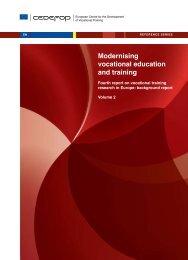measuring the outputs and outcomes of vocational training
measuring the outputs and outcomes of vocational training
measuring the outputs and outcomes of vocational training
You also want an ePaper? Increase the reach of your titles
YUMPU automatically turns print PDFs into web optimized ePapers that Google loves.
8<br />
collection is likely to be <strong>the</strong> most effective vehicle to ga<strong>the</strong>r information on VET <strong>and</strong> to generate<br />
indicators in this area.<br />
The UOE data collection is ano<strong>the</strong>r secondary collection <strong>of</strong> data ga<strong>the</strong>red from administrative<br />
sources (registers <strong>of</strong> educational institutions), run jointly by <strong>the</strong> UNESCO Institute for Statistics<br />
(UIS), <strong>the</strong> OECD <strong>and</strong> Eurostat. The units responsible for reporting are <strong>the</strong> ministerial departments/<strong>of</strong>fices<br />
in charge <strong>of</strong> statistics or <strong>the</strong> National Statistical Institute <strong>of</strong> each country. UOE is <strong>the</strong><br />
basic source <strong>of</strong> information for attainment in VET, allowing separate reporting on pre-<strong>vocational</strong> <strong>and</strong><br />
<strong>vocational</strong> programmes; output indicators by type <strong>of</strong> programme (str<strong>and</strong>) can be made available.<br />
One problem with <strong>the</strong> UOE data is <strong>the</strong> ‘netting out’ <strong>of</strong> graduates from different years or earning multiple<br />
qualifications during <strong>the</strong> reference school year. Ano<strong>the</strong>r problem <strong>of</strong> <strong>the</strong> UOE data is that reporting<br />
is based on an internationally comparable classification <strong>of</strong> educational programmes (ISCED)<br />
which is <strong>of</strong>ten inappropriately used as a proxy for qualifications (see also <strong>the</strong> following sections in<br />
this paper). The mapping <strong>of</strong> qualifications by level <strong>of</strong> education is ra<strong>the</strong>r subject to political negotiations<br />
than underpinned by research, leading to several inconsistencies across countries as to what<br />
should fall under <strong>the</strong> category <strong>of</strong> an ISCED-3 qualification (Behringer <strong>and</strong> Pfeifer, 2004). Eurostat is<br />
currently working on a revision <strong>of</strong> <strong>the</strong> UOE data collection aiming to ‘net out’ <strong>the</strong> adults participating<br />
in adult education programmes. In January 2006 Eurostat put forward to <strong>the</strong> two o<strong>the</strong>r partners (UIS<br />
<strong>and</strong> <strong>the</strong> OECD) a proposal for a revision policy <strong>of</strong> <strong>the</strong> UOE, looking at improving <strong>the</strong> comparability,<br />
relevance <strong>and</strong> coherence <strong>of</strong> <strong>the</strong> data. In <strong>the</strong> absence <strong>of</strong> a dedicated data collection on VET, UOE remains<br />
<strong>the</strong> main source for data on <strong>vocational</strong> education <strong>and</strong> <strong>training</strong>.<br />
2. Data ga<strong>the</strong>red from surveys<br />
The Continuing Vocational Training Survey (CVTS) is an enterprise survey carried out by Eurostat<br />
in companies with at least ten employees. There have been two rounds <strong>of</strong> CVTS, one conducted in<br />
1994 for twelve EU Member States <strong>and</strong> ano<strong>the</strong>r round conducted in 2000/01 in all fifteen EU Member<br />
States, Norway <strong>and</strong> nine C<strong>and</strong>idate Countries (<strong>of</strong> which seven became new Member States in 2004).<br />
The survey provides, on a comparable basis for <strong>the</strong> two rounds, information on employer-sponsored<br />
<strong>training</strong> taken during <strong>the</strong> year prior to <strong>the</strong> survey, for employed persons, excluding apprentices <strong>and</strong><br />
trainees. A large set <strong>of</strong> variables for <strong>the</strong> enterprises (such as costs <strong>of</strong> <strong>training</strong>, incidence <strong>of</strong> <strong>training</strong> by<br />
sector, etc.) is available from <strong>the</strong> survey but only a limited number <strong>of</strong> variables relate to employees<br />
(total <strong>training</strong> hours <strong>and</strong> <strong>training</strong> participation). The coverage <strong>of</strong> <strong>the</strong> different forms <strong>of</strong> <strong>training</strong> for<br />
employees refers to <strong>training</strong> courses which take place away from <strong>the</strong> place <strong>of</strong> work (e.g. in a classroom<br />
or a <strong>training</strong> centre, at which a group <strong>of</strong> people receive instruction from teachers/tutors/lecturers<br />
for a period <strong>of</strong> time specified in advance by those organising <strong>the</strong> course (i.e. intended <strong>training</strong>). Initial<br />
<strong>vocational</strong> <strong>training</strong> (pre-<strong>vocational</strong> <strong>and</strong> <strong>vocational</strong> programmes) undertaken by a person when hired in<br />
order to gain <strong>the</strong> competencies required for <strong>the</strong> job is excluded. Post-graduate education is included in<br />
<strong>the</strong> definition <strong>of</strong> <strong>training</strong>. CVTS will be carried out in 2006 in all EU Member States <strong>and</strong> Acceding








